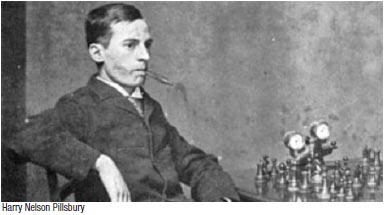
Two days before Massachusetts’s fi rst prominent chess hero’s 139th birthday, 57 players gathered on December 3, 2011 in Leominster at the Veteran’s Center to play in the 2011 Harry Nelson Pillsbury Memorial. Why this is not listed as a Heritage event under USCF guidelines (tournaments held for at least 25 years) is beyond me since I looked back on MACA’s tournament history for this event and it dates back to 1991 . Any records before that are archived with USCF.
I have a chess blog (blunderprone. blogspot.com) that is heavy on the historical perspective of chess, its players and major events. When asked to do the tournament report for this event, I was honored and could not resist tying in a little colloquial historical perspective to this event.
Harry Nelson Pillsbury
Born on December 5th, 1872, he was only 22 when he went to Hastings in 1895 and turned the European chess world on its head as he won the event. He learned to play chess in 1888 at the age of 15. His fi rst chess teacher was Addison Smith, a member of the Boston Chess Club who lived in Somerville.
He moved to Philadelphia by the time he started taking this game seriously at age 17 years old. Pillsbury’s creativity and resourcefulness started to show up in 1890. Pillsbury played a series of Evans Gambits with the veteran Baltimore expert, H.N. Stone. He was one of the inventors of the Stone-Ware defense in the Evans. Our Somerville native smashed him 5-2.
Like Fischer, his knowledge of openings showed his resourcefulness to garnish older variations with his own added twists. This was especially seen at Hastings 1895 where he played a couple of Evans Gambits against Schiffers and Bird. He played a variation not seen in Europe since the days of Kieseritzky and Mayet 50 years earlier. Having trained with this variation from local American players H.N. Stone and Addison Smith, he had an advantage over his European contemporaries.
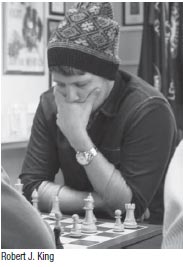
Though our event held in 2011 didn’t attract the European powerhouses of the day, we did have local GM Alexander Ivanov and two prominent local IMs, David Vigorito and Igor Foygel, among the notable players in attendance in the Open section. It was a quick draw in the fi nal round of the 21 player Open section that ended with GM Ivanov and IM Vigorito tied for fi rst place with 3.5 points. Masters Vadim Martirosov and Avraam Pismennyy followed with 3.0 scores. I was hard-pressed to collect any score sheets from these games as IM David Vigorito commented that he stopped recording the last 15 moves of one of his games because of the time control.
One game I collected was from a friend and fellow blogger on chess.com. Although local expert Robert King had not fi nished with any prize money, his fi nal score of 2.5 points came after 1 win and 3 draws, one being against IM Foygel in Round 3. Below is the game he annotated. It appears that IM Foygel has the spirit of Pillsbury as he plays an older line of the Benoni ( 3…e5) against Mr. King, transposing it to an Old Indian Defense.
Robert J. King 2052
IM Igor Foygel 2528
Pillsbury Memorial 2011
[A56] Old Indian Defense
Notes by Robert J. King
1. d4 Nf6 2. c4 c5 3. d5 e5 4. Nc3 d6 5. e4 g6 6. Nge2 (D) (This game was my fi rst experience playing against the Old Indian Defense and I had no theoretical knowledge to go by except for comparing with ideas in the King’s Indian. Here there are a few key
differences to the “normal” KID situations. First is that Black has not spent time playing ...Bg7 and this may help him launch a faster attack via ...Nh5 and ...f5. I would not have judged this as very dangerous if not for the fact that Black has also included the move ...c5, slowing down any Queenside play that White would normally have against a mainline KID.
Knowing this, I judged that normal play with Nf3 may be awkward because standard maneuvers such as Nf3-Nd2 lose their effect because there will be no c4-c5 push to free up the c4 square, and Ng5 ideas may not be possible as Black has the option of playing ...Be7 still. I viewed Nge2 as the most fl exible as I can still play f3 and I still try and maintain control over f4. This may not be the best but not terrible by any means.) 6…Nh5 7. Be3 f5 8. f3 Nd7 9. exf5
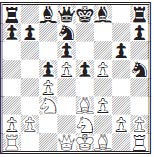
(This normally anti-positional move is best in this situation. The previous move cut off the light squared bishop from the f5 square. Now the h5-e8 diagonal is opened up and more importantly, White can try and gain a tempo attacking the f5 pawn with the queen to try and castle on the queenside.) 9…gxf5 10. Qd3 e4 (Black says there will be no castling yet! This strong pawn sacrifi ce gives Black a very active game.) 11. fxe4 Ne5 12. Qd1
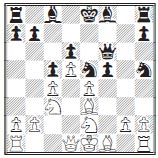
(Qc2 was better. Now White’s king is stuck in the center.) Qf6 (Threatening f4-f3 which would most likely be decisive if achieved.) 13. Ng3 (I spent about 15-20 minutes on this move that looks like positional suicide but is by far the best move in the position. At the cost of ruining the pawn structure on the kingside, which gains control of the f4 square, the half open h-fi le and, most importantly, squashes Black’s attack, White will emerge from this up a pawn without any clear compensation for Black.) 13…Nxg3 (Forced as the only other variation to consider is no good: 13. ... Ng4 14. Nxh5 Qh4+ 15. g3 Qxh5 16. Be2 and White is winning.) 14. hxg3 fxe4 15. Qh5+ Qg6 16. Qxg6+ Nxg6 17. Nxe4 Be7 18. Bd3 (Clearly a mistake in view of ...Ne5. Better was 18. Bf4! placing pressure on the tender d6 square.) 18…Ne5 19. Be2 Bf5 20. Nf2 Rg8 21. g4 (Bf4 was probably better.) Nxg4 22. Nxg4 Bxg4 23. Bxg4 Rxg4 24. b3 Rg7 25. Rc1
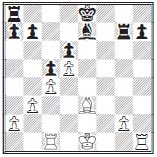
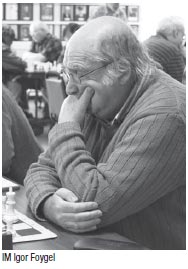
(A seemingly odd move but its idea is seen in the following forcing variation from the game.) 25…Rxg2 26. Rxh7 Rxa2 27. Rh8+ Bf8 28. Bh6 Kf7 29. Rc3 Re8+ (Forced.) 30. Kf1 Ra1+ 31. Kf2 Ra2+ (Black forces a perpetual now. The battle could have continued 32. Kf1 Bxh6 33. Rxh6 Ree2 34. Rf3+ Ke7 35.Rh7+ Ke8 with a draw.) 32. Kf1 Ra1+ 33. Kf2 1/2-1/2
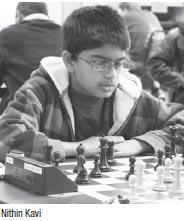
The Under 1900 section had the largest attendance with 27 players. This was my rust breaker event as I had personal matters taking priority over my chess board. Lately, with life in all its complications, the only time I get to play chess is in a one day event. I used to loath such events because of the G60 time controls and how I needed all the time in the world against a much younger opponent brought up on bullet and lightning internet chess. But I have acclimated since my love for the game versus my time for the game are on two separate and seemingly opposing axes.
Given the G60 time control, it comes as no surprise then that an eleven year old, Nithin Kavi, was undefeated and won first place in the U1900 section. Yours truly came in a clear second, playing only the last three rounds. My last round game was a raucous Central variation of the Slav Defense where Black chose to play a minor piece exchange for 3 pawns. Here is that game with my annotations.
George Duval 1787
Allen Wang 1640
Pillsbury Memorial 2011 (4)
[D17] Slav Defense
1. d4 d5 2. c4 c6 3. Nc3 Nf6 4. Nf3 dxc4 5. a4 Bf5 6. Ne5 (The Central Variation) e6 7. f3 Bb4 8. e4 Nxe4
Usually the Bishop takes here in the central variation B v 3Ps (8... Bxe4 9. fxe4 Nxe4 10. Bd2 Qxd4 11.Nxe4 Qxe4+ 12. Qe2 Bxd2+ 13. Kxd2 Qd5+) For some reason my opponent favored the Bishop over the Knight which allows White to avoid the exchange on d2. 9. fxe4 Bxe4 10. Bxc4 Bxg2 11. Rg1 Qh4+ 12. Ke2 (All forced moves) Qxh2 (Black still gets the three pawns for the piece) 13. Ng4 Qh3 14. Nf2 Bf3+ 15. Ke1 Qh2 16. Qxf3
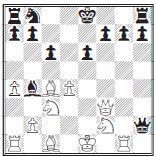
(White risks a rook and three pawns for two pieces and a power play with pieces. Black only has two pieces in play. The Queen and Bishop will need an extra tempo to coordinate due to the separation on the board. The risk was worth taking to gain tempo.) 16…Qxg1+ 17. Ke2 Bxc3 18. bxc3 Qg6 19.Ba3 (This move keeps Black’s king in the center and prevents castling) 19…Qf6 20. Qg3 (I was not ready to exchange. Instead, White plays to penetrate Black’s underprotected fortress) Nd7 21. Ne4 Qg6 22. Nd6+ Kd8 23. Nxb7+ Ke8 24. Nd6+ Kd8 25. Qxg6 fxg6 26. Nf7+ Kc7 27. Nxh8 Rxh8
(Materially speaking, it’s an even game. But Black has 3 isolated pawns and a rook that is out of play.) 28. Rb1 a5 29. Kd3 Re8 30. Bc1 Nb6 31. Bf4+ Kb7 32. Be5 Ka7 33. Rf1 (It was more important to increase my rook’s mobility than to grab a pawn on g7 as Black’s pawn will fall.) Re7 34.Bd6 Rd7 35. Bc5 g5 36. Bxe6 Rb7 37. Ke4 Kb8 38. Rf8+ Ka7 39. Rc8 1-0
The Under 1500 section had a total of 9 players and a three-way tie for fi rst place from the Granite State as James Benway, Robert B Walton Jr, and Anson O’Young, all from New Hampshire, fi nished with 3 points each. I didn’t get a chance to collect any of these games from that section.
|